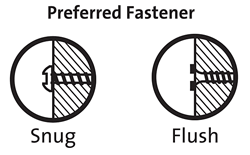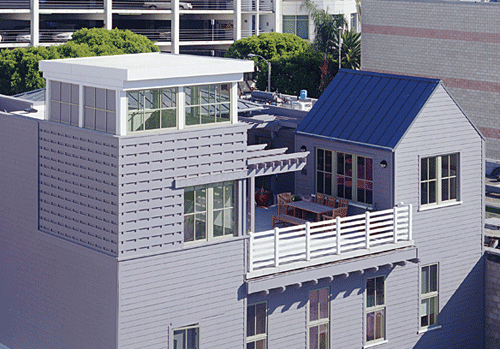Intrinsic Materials: Modernism, Sustainability and Fiber Cement Panels
Trim Profiles: Grids, Washers and Fasteners -Â Durable Construction by Design
Aluminum trim parts for the constructed grid that frames the fiber cement panel include a variety of profiles as shown in the table. It is important that these exterior flanges do not catch any water or be used as a top header for windows or doors. Exposure to standing water may damage the fiber cement panels, and limit their durability. Drip cap is to be used to flash above windows or doors as well as for other penetrations that need flashing. The professional should review the manufacturer's recommendations for all installations in order to increase the durability of this product.
 |
Samples of typical trim pieces for fiber panels with expressed trim profiles |
|
 |
Profile | Description |
|
 |
Vertical Trim Utilize as vertical trim when abutting panels and producing a 1/2" seam. Vertical trim is designed to fit under Horizontal Trim. Never install vertical trims in horizontal applications. |
 |
Horizontal Trim Designed to be installed at horizontal abutments of panel and run in a continuous detail across the face of the structure. |
|
 |
Horizontal Trim - Termination Factory cut ends for termination into outside corner trims. One end has left hand cut with the other end having a right end cut. |
|
 |
Outside Corner Trim Utilized on the outside corners of structure to provide a clean aesthetic detail. Recommended to be run in a continuous vertical detail from bottom to top of corner. |
|
 |
Inside Corner Trim Used to complete inside corners of structure. Recommended to be run in a continuous vertical detail from bottom to top of corner. |
|
 |
J-Channel Trim Designed to terminate panels when abutting windows, doors or other penetrations. Never install J Channel in a manner that exterior flange can catch water. J Channel should not be used on the top header of doors or windows. |
|
 |
Drip Cap Trim Used to flash above windows, doors and other penetrations |
|
Â
 |
| Examples of exposed fasteners. |
Fasteners
Manufactures should provide information on the appropriate fastener spacing. For greater durability, fasteners should be corrosion resistant, galvanized, or stainless steel. Electro-galvanized fasteners are acceptable but may sometimes exhibit premature corrosion.
Exposed fasteners are recommended on fiber cement panels to increase the sutainability fo this product. Fasteners can be hand nailed, screwed or fastened with a pneumatic tool with care that the fastener is driven snug with the surface of the siding.
Non-toxic and low-VOCÂ paint
Fiber cement panels are finished in water-based, low-VOC, acrylic paint. Manufacturers recommend that designers choose a flat finish versus a gloss finish for the panel surfaces. When finished, the look of a panel has often been compared to that of a metal panel. However, a metal panel does not provide the same visual stability of this solid surface and can show warping or denting across the face of a building. Aesthetically, this choice also reflects the actual surface properties of a cement panel. A gloss finish can be affected by temperature when painted and can be more difficult to apply in the field. A contractor painting a surface in the morning on the South wall may find that the gloss finish dries with a different value when applied in the afternoon on the North wall of the building. Stains should never be used on fiber cement panels.
Cost effective - reported industry savings
When compared to the many alternatives, metal, brick, masonry, vinyl or synthetic stucco, fiber cement panels are a cost efficient cladding alternative for commercial buildings. Prefinishing can also saves money instead of painting the building on site.
Installation costs for this manufactured material are also lower as this system is simple to install and uses traditional building methods and tools. According to the "Cost Versus Value Report"6 published in theRemodeling magazine 2009 publication, siding replacement with fiber cement products has ranked number one for four years as the leader in returning value for residentail remodeling and home resales. The fiber cement panel with the grid system is a new alternative to much more complex panel systems and professionals should expect future cost comparisons will prove to be in favor of this cladding choice for the commercial market.
CONCLUSION
Unique, sustainable and mass produced
Fiber cement panel solutions with expressed seams have unique design and environmental properties. They are durable, nontoxic and economical. They do not require sophisticated field
assembly or construction. As an external cladding, fiber cement panels provide a primary defense to moisture, rain, snow, or hail and when combined with the secondary defense of the weather barrier, they are a recognized component of a well constructed, integrated wall system by design teams. Impact and fire resistant, lighter than other masonry products, this product is becoming a leading choice for buildings seeking LEED® certification or other green building ratings from residential to commercial applications.
Mid-century designers like Ray and Charles Eames, who experimented with industrialized forms and panels in the design of their own California home "Case Study #8" could have used this new material as a means to develop a pure form based on the principals expressed by Mondrian.
The benefits of these panels is their affordability even when customized and as demonstrated in the case studies provided, they can be used by designers of low budget, affordable housing projects. There is almost an unlimited variety of orthagonal grid forms and patterns that the designer can choose to use. The pattern unit, size and rhythm is designed as the prerogative of the designer not a result of a standard size determined by the manufacturer. By freeing the panel from the wall construction, the elements of design are another layer of the constructed system working both independently as a formal consideration as well as part of the structural form.
Architecture has the ability to transform reality. Sustainable, intrinsic building materials that are mass produced as well as
provide a palette for unique design intentions will provide a means for new contemporary designs for the future.
 |
Architects of The Natural Resources Defense Council - Robert Redford Building chose fiber cement panels as the most sustainable material option to replace the damaged wood frame of this downtown building. Photo: © Tim Street-Porter |
Â
Footnotes 1 2 3 4 5 6 |
Â
|










